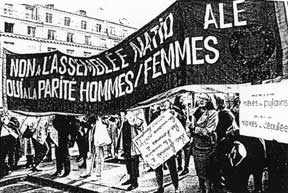The Origins of Parité
 Parisians made history last week in electing Anne Hidalgo the first female mayor of Paris. In her victory speech, the rising leader hailed change, but refrained from claiming victory, touting, “I am the first woman mayor of Paris. I am aware of the challenge.” As Madame la Maire intimates, her achievement—and the path she paved to reach it—has not been without struggle, spurring reflection on the parité movement, which partly inspired the formation of Political Parity.
Parisians made history last week in electing Anne Hidalgo the first female mayor of Paris. In her victory speech, the rising leader hailed change, but refrained from claiming victory, touting, “I am the first woman mayor of Paris. I am aware of the challenge.” As Madame la Maire intimates, her achievement—and the path she paved to reach it—has not been without struggle, spurring reflection on the parité movement, which partly inspired the formation of Political Parity.
France’s part in the 1992 Athens Charter in Greece inspired a push for gender equity in government. That same year, well-known activists Françiouse Gasparde, Claude Servan-Schreiber, and Anne Le Gall published their book, Au pouvoir citoyennes! Liberté, Egalité, Parité (Women Citizens to Power: Liberty, Equality, Parity), propelling parity into the public spotlight and provoking an outpouring of activism and commentary on the issue. As equal representation in political office gained momentum among citizens, women’s associations formed a network—Femmes pour la Parité—to raise awareness about women’s political underrepresentation, pressure the French political class, and organize for national policy reform to ensure parity.
The following year marked a turning point; an advertisement appeared in the newspaper Le Monde titled “The Manifesto of the 577 for a Parity-Democracy,” which was signed by 289 women and 288 men, symbolizing all of the deputies in the French National Assembly. The full-page spread demanded a law or constitutional amendment be brought before the people ensuring equal representation. The call captured national attention.

Demonstration for parity in the Lower House of Parliament France, 1993.
In 1995, under mounting pressure for parity following presidential elections, President Jacques Chirac established the Observatoire de la Parité, a governmental body under the Commission for Parity between Men and Women in Public Life designed to report gender inequities to the Prime Minister. Later that year, then-Prime Minister Alain Juppé ignited uproar when he dismissed eight of the twelve women in his government just months after their appointments—an incident dubbed “Black Tuesday” by the U.S. press.
Shortly thereafter, a manifesto was published in the newspaper L’Express by 10 prominent female politicians of various ideologies, demanding “guaranteed equal representation within the written law.” This publication emerged as a product of these women meeting regularly over the course of one year, crossing party lines, and it heavily influenced public opinion. Polls indicated the desire for female representation among the political elite. A subsequent vote for reforms, brought before the people, confirmed that the majority of the populace believed that “a democracy without women was a disfigured democracy.”
Trumpeting the revitalization of political institutions, Former Socialist Prime Minister Jospin emerged as a strong advocate for parity law. His proposed changes to Article 3 of the Constitution volleyed between both houses of the legislature, until today’s parity law, which requires “equal access of women and men to electoral mandates and elective positions,” was adopted on June 6, 2000.
France became the first country in the world to legislate that, for most elections, the number of male and female candidates must be equal. Yet the law isn’t perfect. The Guardian reports that the two leading parties (Socialists and the Union for a Popular Movement) often choose to pay punitive fines rather than ensure women and men are equally represented on nearly all election ballots. The smaller parties, which are less able to pay the fines, are more compliant with the law, and most have found a way to ensure parity among their candidate lists. Still, because of the resistance from the major parties, parity has been slow in coming to fruition. Currently, only 27 percent of Members of Parliament in the Assemblée Nationale (lower house) are female, along with only 22 percent of representatives in the Sénat (upper house).
The United States lags behind, with women making up only 18.5 percent of the House and 20 percent of the Senate.
But there are lessons to be learned here; the parity law would likely have stalled if French women hadn’t engaged its conservative and liberal parties. Political Parity’s commitment to nonpartisan collaboration remains a critical part of our work, evidenced by our diverse leadership team. The parité movement reminds us there’s much work to be done, but by convening stakeholders, empowering activists, disseminating actionable research, and speaking out about women’s underrepresentation, liberté, egalité, and parité are well within reach.
What will it take to achieve parité in the United States? Share your thoughts with @NadiaFarjood and @PoliticalParity!
This post was inspired by Yvette Roudy who served as a member of Comité Directeur of the Socialist Party, after which she became National Secretary for Action Féminine in 1977. She was subsequently elected to the European Parliament in 1979 and has held several elected posts in France. Roudy held office as Minister for Women’s Rights from 1981 to 1986, where she advocated for the adoption of laws designed to empower women in French politics.
This post references content from the White House Project’s Summit publication Why Women Matter: Lessons About Women’s Political Leadership From Home & Abroad (Page 34), prepared by Parity’s Shauna Shames.
